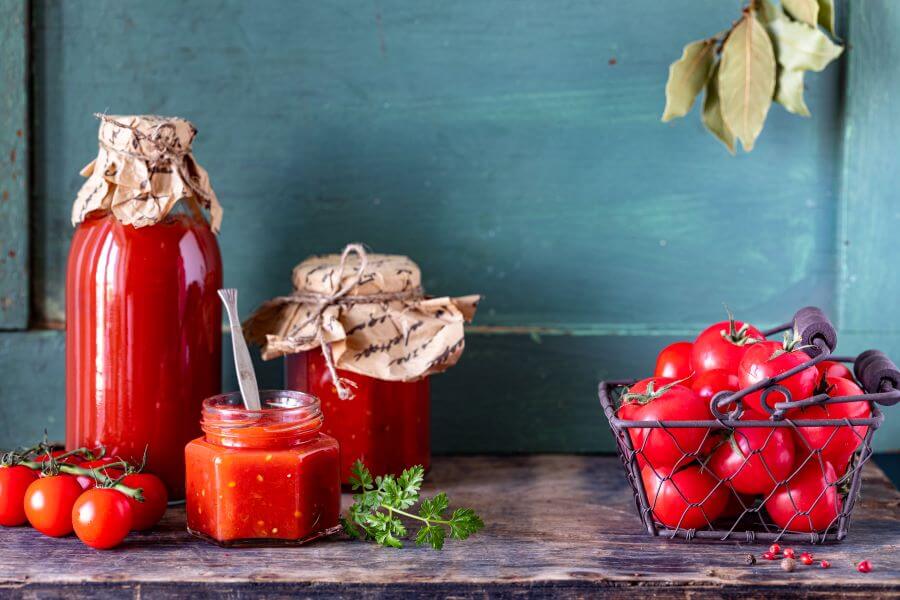Different methods and recipes for canning tomatoes have been passed down through generations. Regrettably, some canning recipes do not effectively eliminate the possibility of spoilage microorganisms.

Adding lemon juice to canned tomatoes is often recommended because it helps to increase the acidity of the tomato. Many would rather skip this method than add lemon juice when canning tomatoes.
A common reason for this is it ruins the flavor of the tomatoes. If you are on this train, here’s how to safely can your tomatoes without adding lemon juice.
Should You Pressure Can Tomatoes Without Lemon Juice?
USDA researchers developed the pressure canning process for tomatoes primarily to eliminate molds, yeasts, and other spoilage organisms.
However, you need to add a form of acid to your canned tomatoes, even if you’re pressuring canning. You can either decide to use other alternatives to lemon juice or skip this process altogether.
Tomatoes have varying levels of acidity depending on their variety. Some are known for their high acidity, while others are sweeter and less acidic. Generally, to be safe, You should, however, acidify the tomatoes.
If you don’t like using lemon juice, you can pressure your tomatoes without it, but it is recommended to include another form of acid. This reduces the risk of botulinum bacteria, a potentially deadly foodborne illness.
The C. botulinum spores remain dormant in acidic environments. Whether using boiling water bath canning or pressure canning, you can prevent C. botulinum spores by following an approved recipe and correctly processing the jars.
It’s essential to follow the proper procedures to ensure the safety and preservation of the tomatoes.
Aside from lemon juice, you can use other acidic alternatives like:
Vinegar
Vinegar is the most common substitute for lemon juice when canning tomatoes. You can use either the white vinegar or cider vinegar. Add two tablespoons of vinegar per quart jar or one tablespoon per pint jar.
The vinegar must be at least 5% acidic for this to work. Also, the National Center for Home Food Preservation recommends adding a little sugar if you’re using vinegar. This is to offset the vinegar’s flavor.
Citric Acid
You would find powdered citric acid at most stores that sell canning supplies. Follow the manufacturer’s instructions. Typically, you’ll use about 1/4 teaspoon per pint jar or 1/2 teaspoon per quart jar.
Although many sources claim you can substitute citric acid with ascorbic acid, recent research shows otherwise. The authors of Putting Food By agree that Ascorbic acid or Vitamin C does not prevent botulism. Beyond this, ascorbic acid could add a bitter taste to the tomatoes.
Tomato Paste
Some people use tomato paste as an alternative to lemon juice for added acidity. It is more concentrated than whole tomatoes, so it can help increase the overall sharpness of your canned tomatoes. Add a tablespoon or two of tomato paste to each jar.
Lime Juice
While it is less common than lemon juice, lime juice can also be acidified. The recommended amount is similar to lemon juice. Use two tablespoons per quart jar or one tablespoon per pint jar.
Orange Juice
You can use orange juice for acidification when you’re in a bind. That is, where none of these alternatives are even remotely available. Orange juice is less acidic than lemon or lime juice so you may need more. Start with three tablespoons per quart jar and adjust based on taste and acidity.
NOTE
Always check the acidity level of the alternatives you use. This is because acidity can vary between brands and types of these acidifying agents. Always follow the recommended guidelines for safe canning practices.
How Can You Safely Can Tomatoes Without Lemon Juice?
Use Fresh, Ripe Tomatoes

First, you want to make sure you’re selecting tomatoes that are free from any signs of spoilage or infection. Wash them thoroughly in clean, cold water, and remove any blemishes or bruises.
Sterilize Your Canning Equipment
Ensure your canning jars, lids, rings, and equipment are sterilized. You can do this by boiling the jars and lids in a large pot of water. Do this for at least 10 minutes; use a dishwasher with a sterilizing cycle.
Prepare The Tomatoes
You can peel the tomatoes by blanching them in boiling water for about 30 seconds. Then, you can transfer them to an ice bath. This will make it easier to remove the skins. Remove the cores and cut the tomatoes into chunks, or leave them whole, depending on your preference.
Pack The Jars
Pack the prepared tomatoes into the sterilized canning jars, but leave about 1/2 inch of headspace at the top. It’s essential to avoid overfilling the pots to prevent the risk of spoilage.

Add Salt
This is an optional process. You can also decide to add the salt according to your taste. Typically, you should add half a teaspoon of salt per pint jar or One teaspoon per quart jar for flavor.
Seal The Jars
Wipe the rims of the jars with a clean, damp cloth to ensure no residue could prevent a proper seal. Place the sterilized lids on the jars and screw on the rings until they are fingertip-tight. Make sure it’s tight enough.
Use A Pressure Canner
It would help to use a pressure canner, not a water bath canner, when canning tomatoes without added acidity. Follow the manufacturer’s instructions for your specific pressure canner.
Process The Jars
Process the jars of tomatoes in the pressure canner according to the recommended pressure and time for your altitude. Typically, you’ll process pint jars at 11 pounds of force for 15 minutes and quart jars for 20 minutes. Always consult your pressure canner’s manual for precise instructions.
Process In A Boiling Water Bath
Place the filled jars in a boiling water bath canner. Fill enough hot water to cover the jars by at least 1 inch. Bring the water to a boil and process for the recommended time. This would be usually 40-45 minutes for quart jars.
Cool and store
Once the processing time is complete, turn off the heat and allow the canner to depressurize naturally. Afterward, carefully remove the jars and place them on a clean, dry towel or cooling rack. Let them cool completely.
Check the seals
After the jars have cooled, check the seals by pressing down on the center of each lid. The pot is sealed correctly if the top doesn’t pop back when pressed. Any unsealed jars should be refrigerated and used within a few days.
Following these steps, you can safely pressure your tomatoes without adding lemon juice. However, pay close attention to cleanliness, the timeline, and altitude adjustments to preserve your tomatoes.
It is important to note that using an acid, like lemon juice or vinegar, is a recommended practice for safety. This ensures the protection and preservation of canned tomatoes, especially if the tomatoes are low in natural acidity.
Finally, always stay updated with the canning guidelines for tomatoes. They continually evolve as time passes, so adhering to the latest recommendations for canning tomatoes is essential.
